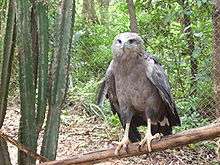Chaco eagle
| Chaco eagle | |
|---|---|
 | |
| Scientific classification | |
| Kingdom: | Animalia |
| Phylum: | Chordata |
| Class: | Aves |
| Order: | Accipitriformes |
| Family: | Accipitridae |
| Genus: | Buteogallus |
| Species: | B. coronatus |
| Binomial name | |
| Buteogallus coronatus (Vieillot, 1817) | |
| Synonyms | |
|
Harpyhaliaetus coronatus | |
The Chaco eagle, or crowned solitary eagle (Buteogallus coronatus), is an endangered bird of prey from eastern and central South America. Typically it is known simply as the crowned eagle which leads to potential confusion with the African Stephanoaetus coronatus. The Chaco eagle is a large raptor with a length of 73–79 cm (28.5–31 in), a wingspan of 170–183 cm (67–72 in) and an average weight of 2.95 kg (6.5 lb). Adults are almost entirely gray with a large occipital crest and a short, black-and-white-banded tail. The juvenile is gray-brown on the back and pale with gray-brown streaks on the head and underside.
Habitat
The Chaco eagle lives in Argentina, Brazil, Paraguay and Bolivia. It tends to live in open woodland and marshland, unlike its closest relative, the montane solitary eagle, which lives only in dense mountain forest. Found in large trees, the nest of this species is a large platform of sticks about 1.2 m (3.9 ft) across and 30 cm (12 in) deep. One nest was noted to be at the top of a tree that also contained a communal nest of monk parakeets. Eggs were recorded in October and young in May but nothing more is really known about its breeding activities, except that they lay only one egg per reproductive cycle. It is largely threatened by habitat destruction, since its native habitat has been greatly compromised by the spread of agriculture and cattle ranching.
This species is considered endangered by BirdLife International, and the IUCNRedlist because of its very low density, and the threats that it faces.[2]
Diet
It is often noted for its sluggish movements during the day and is believed to be largely crepuscular in activity. It preys principally on mammals, including armadillos, skunks, weasels, rodents and monkeys. It also hunts reptiles (principally snakes), fish, domestic lambs and occasionally birds, including tinamou and poultry.
Population
The total population of this species is in the area of 250-999 mature individuals, equaling to 375-1,500 individuals in total, Can be rounded up to 350-1,500 individuals.
The main reasons the population is so low is because of hunting, habitat loss and more.
References
- ↑ BirdLife International (2016). "Buteogallus coronatus". The IUCN Red List of Threatened Species. IUCN. 2016: e.T22695855A93530845. doi:10.2305/IUCN.UK.2016-3.RLTS.T22695855A93530845.en. Retrieved 13 January 2018.
- ↑ "Crowned Solitary Eagle". Birdlife International. Retrieved 25 December 2017.
- BirdLife Species Factsheet
- SARASOLA, J.H. and J.J. MACEDA. 2006. Past and current evidence of persecution of the endangered Crowned Eagle Harpyhaliaetus coronatus in Argentina. Oryx 40:347-350.
- SARASOLA, J.H., SANTILLÁN, M.A. and M.A. GALMES. 2010. Crowned eagles rarely prey on livestock in central Argentina: persecution is not justified. Endangered Species Research 13: 207-213
- "Raptors of the World" by Ferguson-Lees, Christie, Franklin, Mead & Burton. Houghton Mifflin (2001), ISBN 0-618-12762-3.
